Passport characteristics, scope of delivery and price
| Manufacturer | Arctic |
|---|---|
| Model name | Freezer 34 eSports Duo |
| Model code | ACFRE00074A, EAN: 4895213702218 |
| Type of cooling system | for an air tower processor with active airflow from a heatsink located on heat pipes |
| Compatibility | motherboards with processor sockets: Intel: 1200, 115X, 2011-3*, 2066* (* square); AMD: AM4 |
| Cooling capacity | TDP 210W |
| Fan type | axial (axial), 2 pcs. |
| Fan Model | BioniX P120 |
| Fan power | 12 V, 0.13 A; trigger voltage 4.3V |
| Fan dimensions | 120×120×27 mm |
| Fan speed | 200-2100 rpm |
| Fan performance | 114.9 m³/h (67.56 ft³/min) |
| Fan static pressure | 27.0 Pa ( 2.75 mm w.c.) |
| Fan noise level | 0.45 sona |
| Fan bearing | hydrodynamic (Fluid Dynamic Bearing) |
| Fan life | there is no data |
| Cooler Dimensions (H×W×D) | 157×124×103mm |
| Cooler weight | 764 g |
| Radiator material | aluminum plates (0.4 mm thick, 54 pcs.) and copper heat pipes (4 pcs. ∅6 mm, direct contact with the processor cover) |
| Heat sink thermal interface | thermal grease Arctic MX-4 in a syringe |
| Connection | fans: in series to each other and into a 4-pin connector (power supply, rotation sensor, PWM control) for a processor cooler on a mat. board |
| Peculiarities |
|
| Scope of delivery (better to check before buying) |
|
| Retail offers |
Description
The processor cooler is delivered in a strictly designed box made of thin corrugated cardboard.
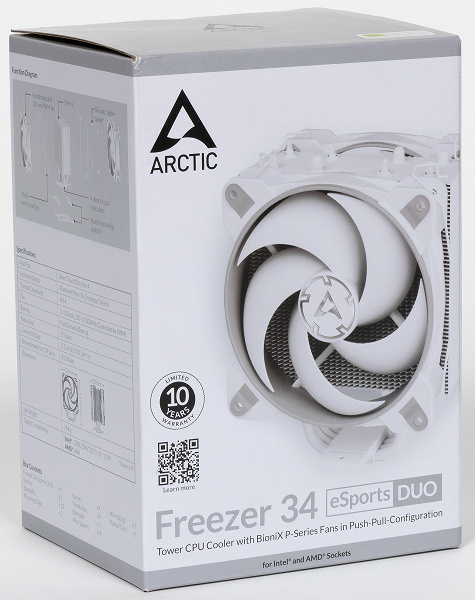
On the outer planes of the box, not only the product itself is depicted, but also the technical characteristics are listed, the equipment is indicated and there are QR codes for easy navigation through the links related to the product. A number of design features are clearly explained with the help of drawings and diagrams, there is even a diagram comparing the cooling capacity with two other coolers. The inscriptions are predominantly in English, but the listing of features is duplicated in several languages, including Russian. Corrugated cardboard inner box and liners and plastic bag are used to protect and distribute the parts. The sole of the heat sink is protected by a plastic film.
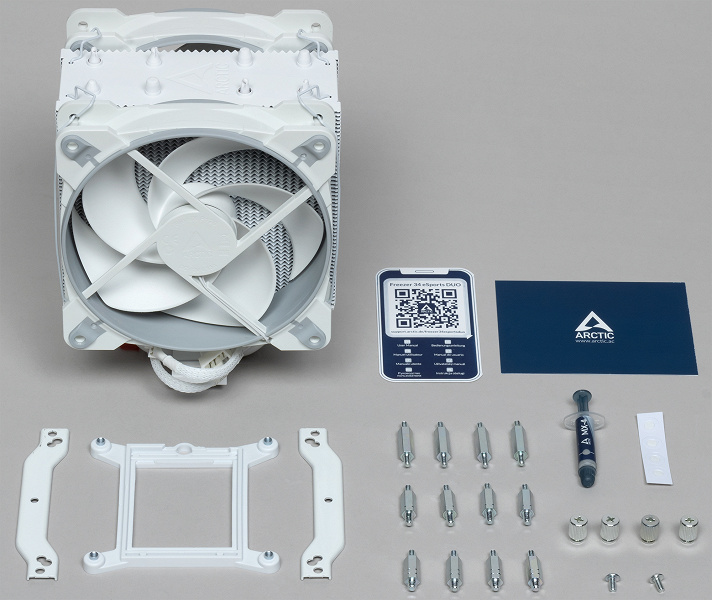
There is no printed instruction, and it cannot even be downloaded from the site, you can only follow the link in the QR code and view the interactive manual on the company’s website. This is not very convenient. Also on the company’s website there is a description of the system and a PDF file with characteristics .
The fasteners are made mainly of hardened steel (the frame on the back of the motherboard is plastic, but strong and with stiffeners) and has a durable galvanized coating or white semi-matte paintwork. The second type of coating is present on all surfaces of the radiator, including mounting brackets and heat pipes, with the exception of the working planes of the heat sink base. Three types of threaded racks are used, and notches on the ribs help to distinguish them.
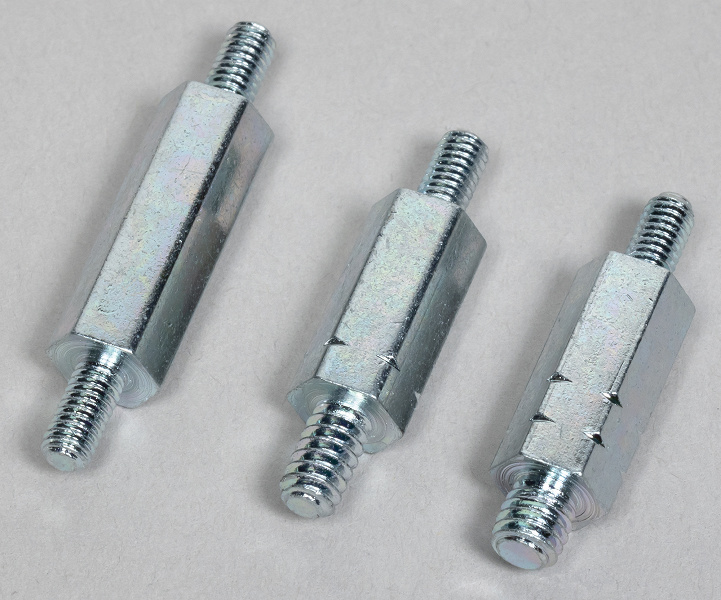
The cooler is equipped with a remote radiator, to which the heat from the sole is transferred through four heat pipes. The tubes are, of course, copper. At the base of the heat sink, the tubes are flattened and pressed into a thick aluminum plate with mounting lugs. The planes of the tubes adjacent to the processor are ground and slightly polished. There are barely pronounced grooves on the sole of the heat sink between the tubes. The working plane of the heat sink is almost perfectly flat.
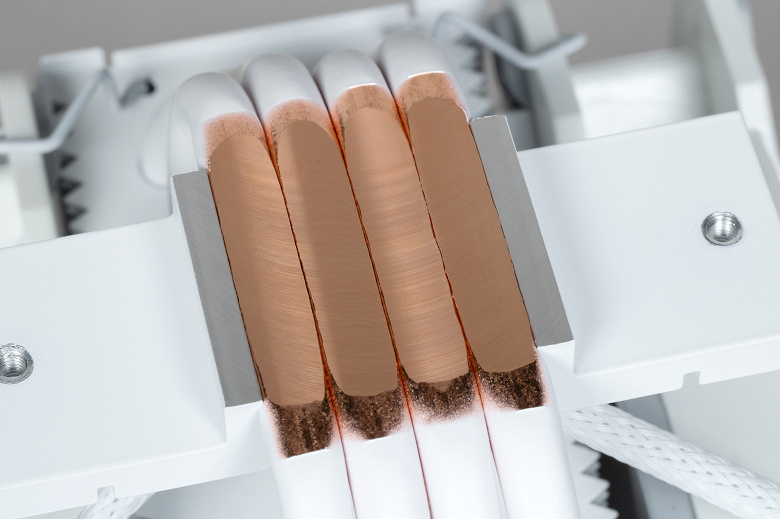
Thermal grease Arctic MX-4 in a small syringe, which, of course, is less convenient than the pre-applied layer. A complete supply of thermal paste should be enough for two times in the case of processors with a small cover area and at economical consumption. The tests used no less high-quality thermal paste from the same manufacturer. The manufacturer recommends applying thermal paste in strips along the heat pipes, which we did:
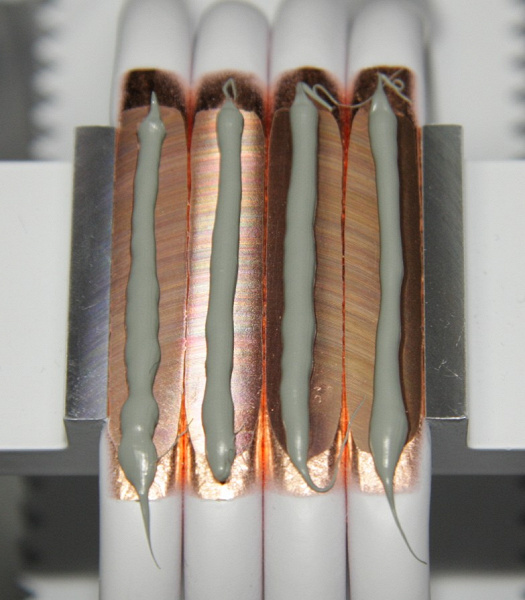
Looking ahead, we will demonstrate the distribution of thermal paste after the tests are completed. On an Intel Core i9-7980XE processor:
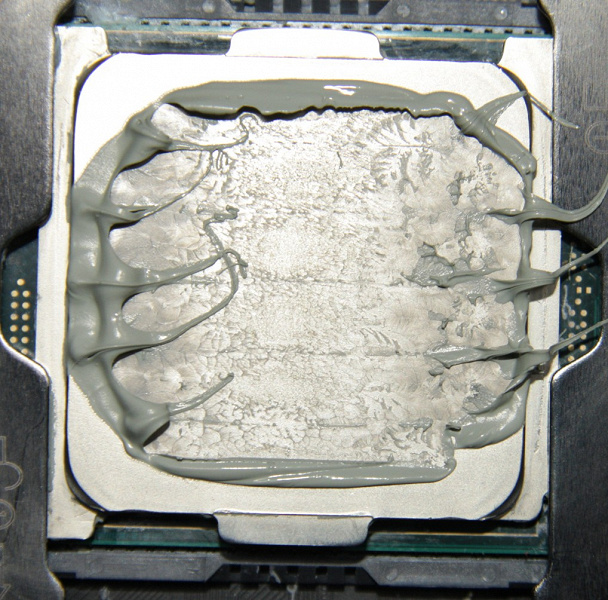
And on the sole of the heat sink:
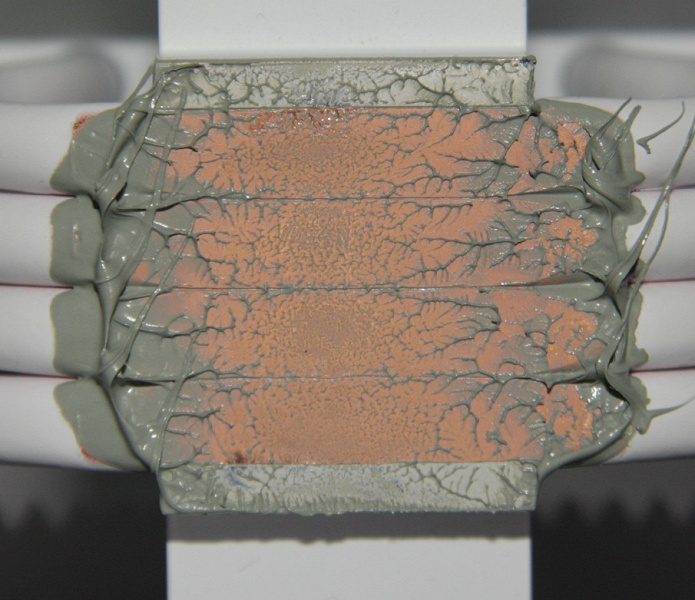
It can be seen that the thermal paste was distributed in a thin layer over a large area in the center of the processor cover, and its excess was squeezed out along the edges. In the central regions of the heat pipes there are pronounced patches of tight contact. Note that the cover of this processor is not perfectly flat, but slightly convex.
And in the case of the AMD Ryzen 9 3950X processor. On processor:
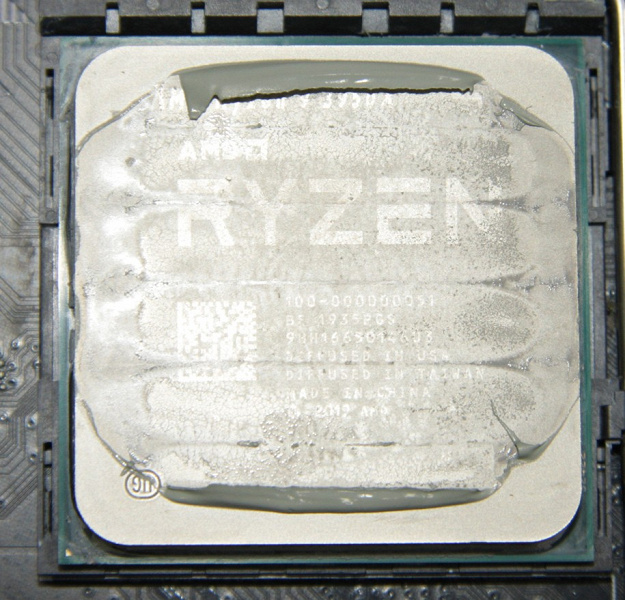
On the sole of the heat sink:
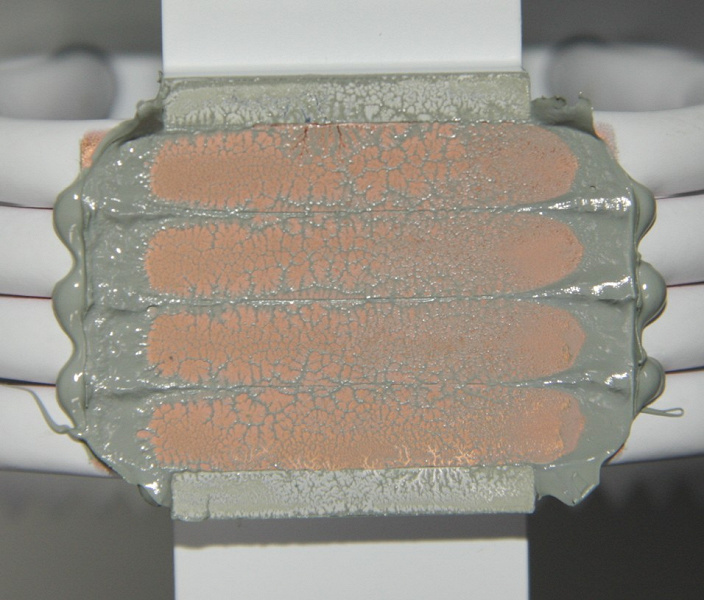
In this case, the thermal paste layer is also very thin on most of the CPU cover, and the tight contact patches are larger.
The heatsink is a stack of aluminum fins tightly fitted onto the heatpipes.
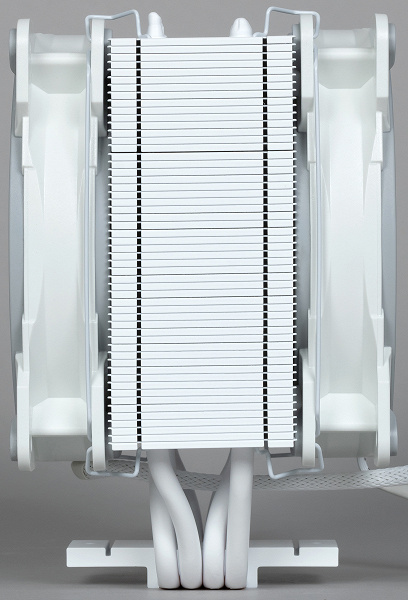
The heat pipes are spaced apart, which should improve the efficiency of the cooler.
The width of the fan is slightly less than the width of the heatsink, and the height is slightly larger than the height of the stack of heatsink fins, so only a small part of the airflow passes by the fins.
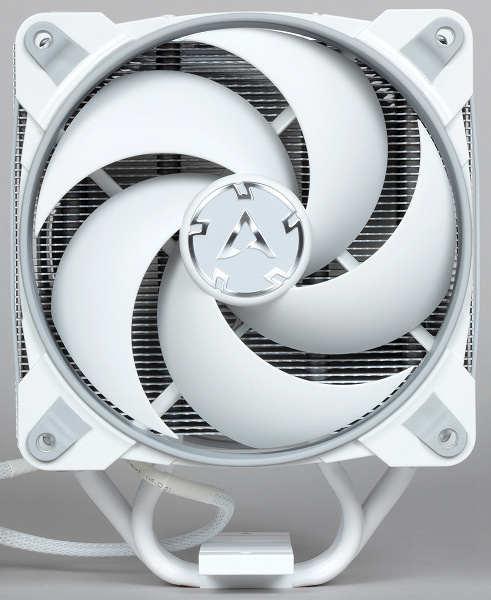
Standard size of the complete fan is 120 mm. The shape of the fan impeller hints at the fan’s ability to create high static pressure, which is what is needed in this case. Composite frame – the base is made of white hard plastic, which is complemented by elements of elastic light gray plastic. We had a gray / white design option for testing. The manufacturer offers five more color schemes for this cooler model:

The height of the white part of the frame is 25 mm, and the inner cylinder made of light gray plastic is 27 mm.
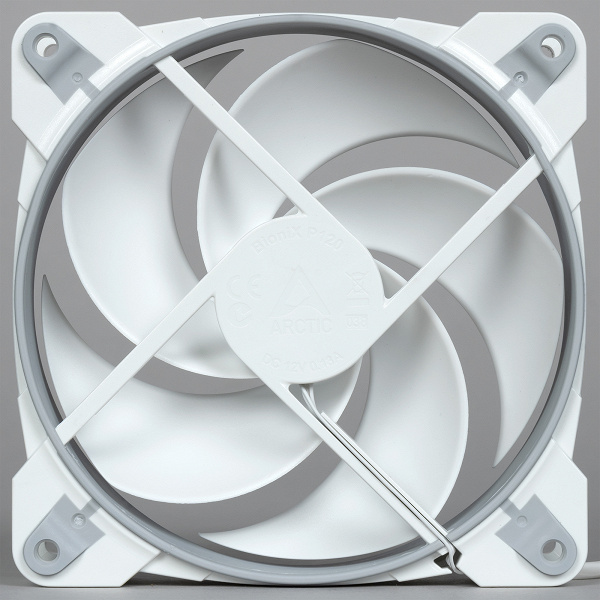
Inserts of the same material in the corners of the fan frame, as conceived by the developers, should provide vibration decoupling of the fan from the attachment point. However, if we estimate the ratio of the mass of the fan to the rigidity of the inserts, it becomes clear that the resonant frequency of the structure is very high, that is, there can be practically no effective vibration decoupling. In addition, the mounting brackets are fixed directly to the rigid frame of the fan and to the radiator fins, which leaves no chance for at least some kind of vibration decoupling. Thick elastic silicone pads are additionally glued to the corners of the exhaust fan, but everything written above applies to them too, they only slightly move the fan away from the radiator, which reduces the efficiency of the system. But since the manufacturer pasted them, then we carried out the tests with these overlays.
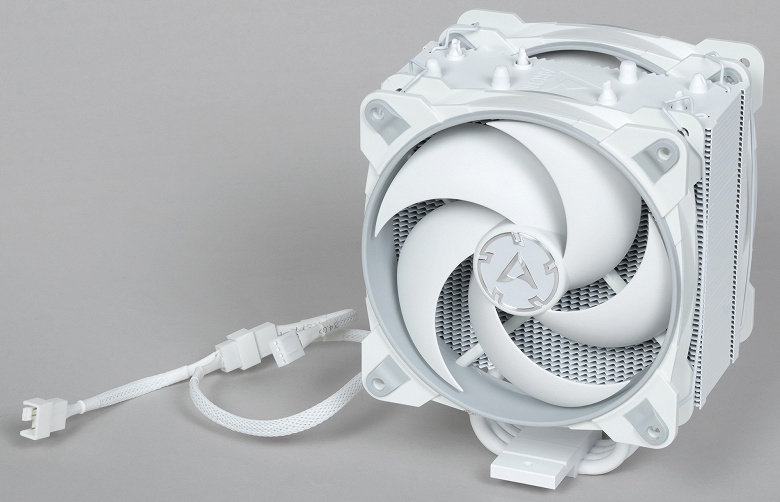
The fan supports PWM regulation. The cable from the fan is encased in a braided sheath of slippery plastic and has a loop-through connector so both fans can be plugged into the same connector without the need for a splitter. Note that the mounting brackets are attached to the heatsink, which increases the ease of installation of the fans.
The cooler is relatively compact. All RAM slots, both on the blower side and on the exhaust side, remain accessible for installing tall memory modules. An illustrative example:
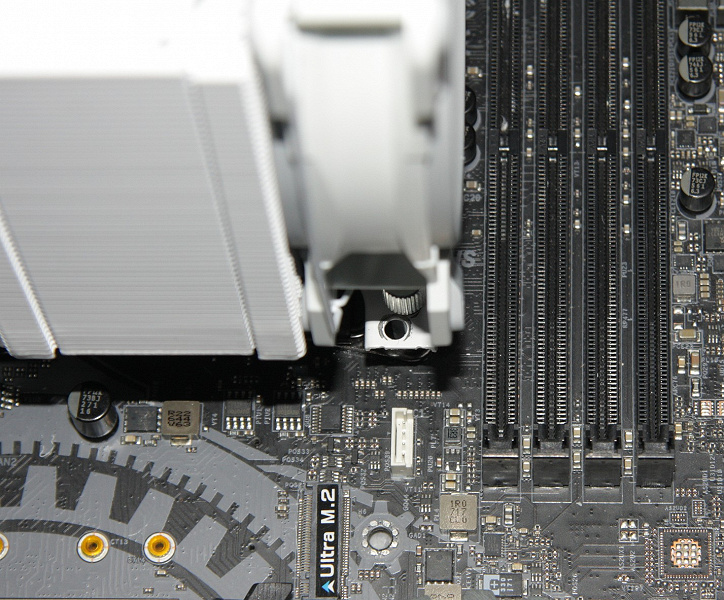
The Arctic Freezer 34 eSports Duo processor cooler has a 10-year manufacturer’s warranty.
Testing
Below in the summary table we present the results of measurements of a number of parameters.
| Height, mm | 157 |
|---|---|
| Width, mm | 124 |
| Depth, mm | 103 |
| Heat sink surface, mm (along CT × across CT) | 25×30.5 |
| Cooler weight, g | 798 (with mounting kit for LGA 2011) |
| Radiator weight, g | 488 |
| Fin height, mm | 106 |
| Fan cable length, cm | 20 + 8.5 |
A full description of the testing methodology is given in the corresponding article ” Testing methodology for processor coolers of the 2020 sample “. For the load test, the powerMax (AVX) program was used, all cores of the Intel Core i9-7980XE processor worked at a fixed frequency of 3.2 GHz (multiplier 32).
Determination of the dependence of the cooler fan speed on the PWM duty cycle and / or supply voltage
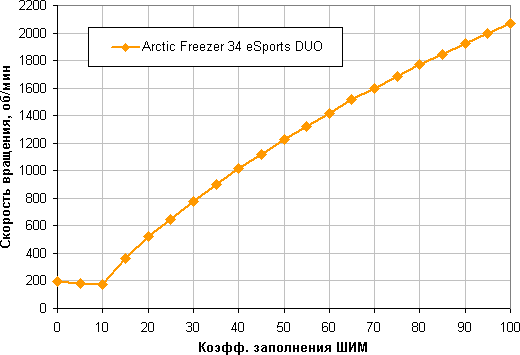
An excellent result is a smooth increase in rotational speed with a change in the duty cycle (SC) from 10% to 100% and a wide range of adjustment. Note that at a short circuit of 0%, the fan does not stop, so in a hybrid cooling system with a passive mode at minimum load, such fans will have to be stopped by reducing the supply voltage.
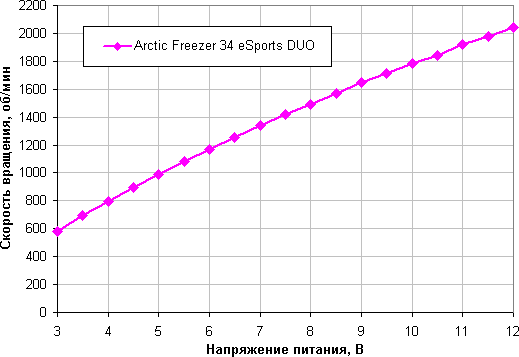
The adjustment range with voltage is noticeably narrower in this case. The fan stops when the voltage drops to 2.8 V and starts from 2.9 V. It is quite acceptable to connect the fan to a source with a voltage of 5 V.
Determining the dependence of the temperature of the processor at its full load on the speed of rotation of the fan(s) of the cooler
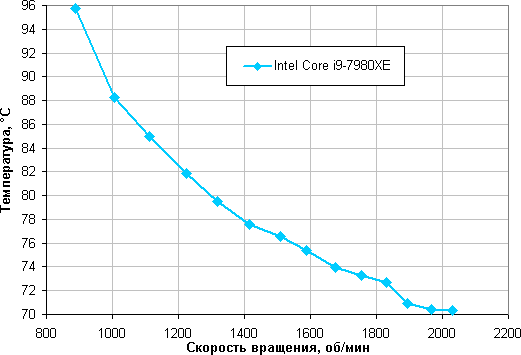
At short circuit = 35%, the cooler under test conditions can no longer cope with the cooling of the Intel Core i9-7980XE processor.
Determining the noise level depending on the rotational speed of the cooler fan(s)
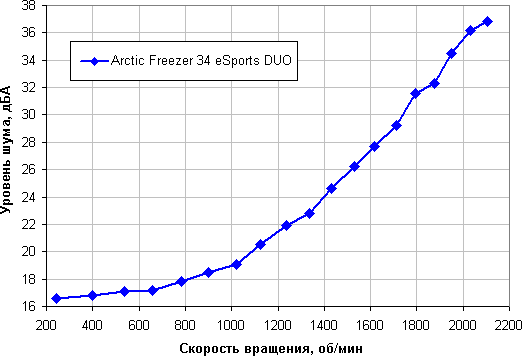
It depends, of course, on individual characteristics and other factors, but in the case of coolers somewhere from 40 dBA and above, the noise from our point of view is very high for a desktop system, from 35 to 40 dBA the noise level is tolerable, below 35 dBA noise from the cooling system will not stand out against the background of typical non-noisy PC components – case fans, on the power supply, on the video card, as well as hard drives, and somewhere below 25 dBA the cooler can be called conditionally silent. The background level was equal to 16.3 dBA (conditional value, which shows the sound level meter). Despite two fans, the Arctic Freezer 34 eSports Duo cooler can be considered a relatively quiet device.
Plotting the dependence of the noise level on the temperature of the processor at full load
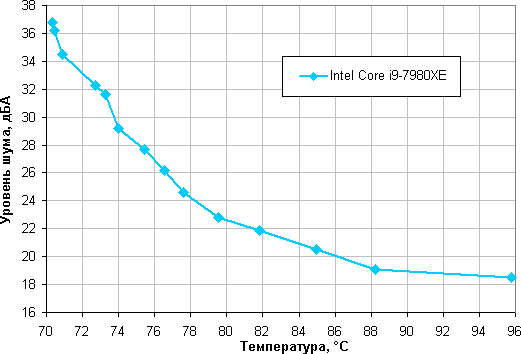
Plotting the dependence of the real maximum power on the noise level
Let’s try to get away from the conditions of the test bench to more realistic scenarios. Let’s say that the temperature of the air taken in by the cooling fan can rise to 44 ° C, but the temperature of the processor under maximum load does not want to be raised above 80 ° C. Restricting ourselves to these conditions, let’s plot the dependence of the real maximum power (denoted as P max (previously we used the designation Max. TDP )), consumed by the processor, on the noise level ( details are described in the methodology ):
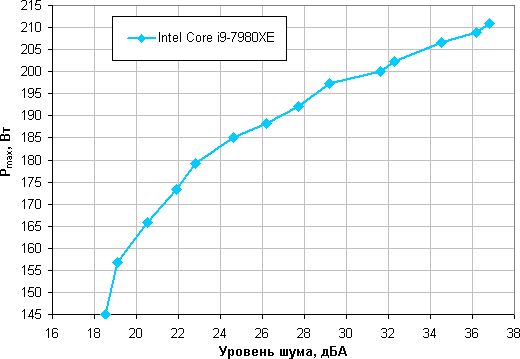
Taking 25 dBA as a conditional noiselessness criterion, we get the approximate maximum power of processors corresponding to this level. This is about 185 W for an Intel Core i9-7980XE processor. If you do not pay attention to the noise level, then the power limits can be increased somewhere up to 210 watts. Let us clarify once again that in harsh conditions of blowing the radiator with air heated to 44 degrees, when the air temperature drops, the indicated power limits for silent operation and maximum power increase.
Comparison with other coolers when cooling the Intel Core i9-7980XE processor
Using this link , you can calculate the power limits for other boundary conditions (air temperature and maximum processor temperature) and compare this system with several other coolers tested using the same method (the list is updated, and therefore placed on a separate page).
Testing on an AMD Ryzen 9 3950X processor
As an additional test, we decided to see how the cooler handles the cooling of the AMD Ryzen 9 3950X . The processors of the Ryzen 9 family are assemblies of three crystals under one cover. On the one hand, increasing the area from which heat is removed can improve the cooling capacity of the cooler, but on the other hand, the design of most coolers is optimized for better cooling of the central area of the processor. Apparently, because of these features, there is an opinion that it is not very easy to choose an air cooler for the top new generation Ryzen processors.
The dependence of the temperature of the processor at its full load on the speed of rotation of the fans:
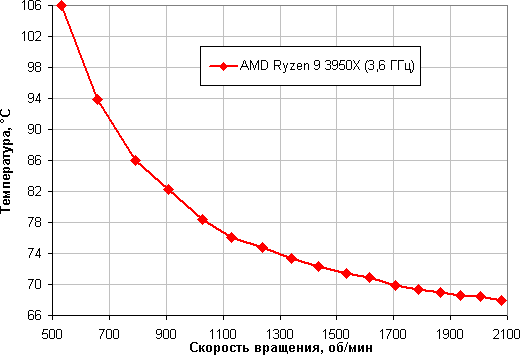
In fact, under test conditions, this processor does not overheat at 24 degrees of ambient air even at a short circuit of 25% (which is about 660 rpm of the fans), at 20% it already overheats (for this CPU, heating up to 95 degrees is allowed).
The dependence of the noise level on the temperature of the processor at full load:
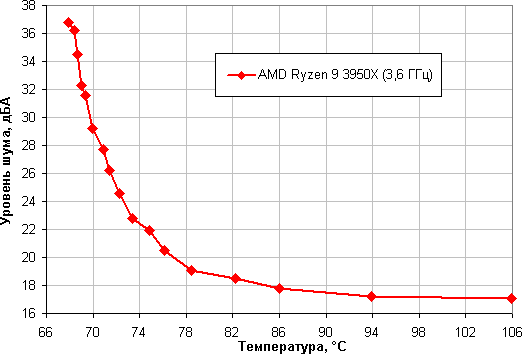
Restricting ourselves to the above conditions, we plot the dependence of the real maximum power (denoted as P max ) consumed by the processor on the noise level:
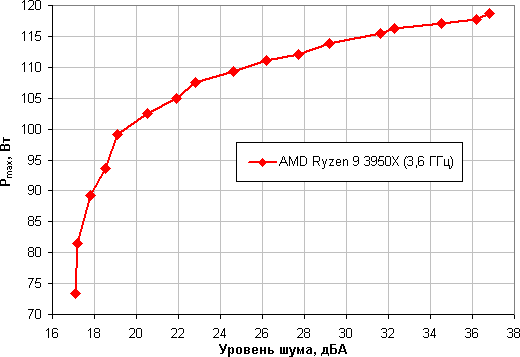
Taking 25 dBA as a conditional noiselessness criterion, we get that the maximum processor power corresponding to this level is about 110 W. If you do not pay attention to the noise level, then the power limit can be increased somewhere up to 120 watts. Once again, we will clarify: this is in harsh conditions of blowing the radiator with air heated to 44 degrees. As the air temperature drops, the specified power limits for quiet operation and maximum power increase. Therefore, provided there is enough good ventilation in the case, this cooler will somehow cope with the cooling of the AMD Ryzen 9 3950X processor, but you should not count on the possibility of significant overclocking.
Comparison with other coolers when cooling AMD Ryzen 9 3950X CPU
Using this link , you can calculate the power limits for other boundary conditions (air temperature and maximum processor temperature) and compare this cooler with several other coolers tested using the same method (the list is being updated, and therefore placed on a separate page).
findings
Based on the Arctic Freezer 34 eSports Duo cooler, you can create a conditionally silent computer (noise level of 25 dBA or less) equipped with an Intel Core i9-7980XE (Intel LGA2066, Skylake-X (HCC)) processor, if the processor consumption under maximum load does not exceed 185 W and the temperature inside the case will not rise above 44°C. In the case of the AMD Ryzen 9 3950X chiplet processor, the cooler efficiency is noticeably lower, and in order to comply with the above conditions, the maximum power consumed by the processor should not exceed 110 watts. With lower cooling air temperatures and/or less stringent noise requirements, the power limits can be increased in all three cases. The advantages of the cooler include a neat design, easy installation and the fact that it does not block the slots for memory modules. Note that the cooler is available in six colors.




